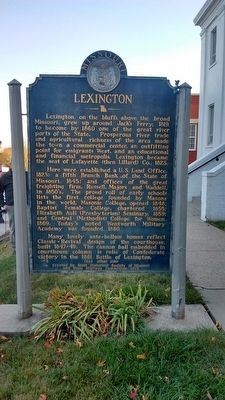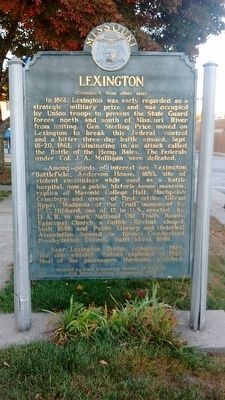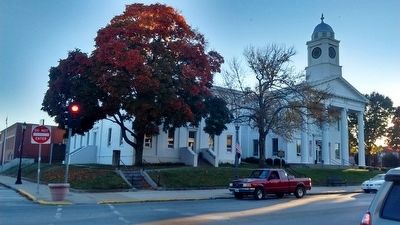Lexington
Side 1
Lexington, on the bluffs above the broad Missouri, grew up around Jack's Ferry, 1819, to become by 1860 one of the great river ports of the State. Prosperous river trade and agricultural richness of the area made the town a commercial center, an outfitting point for emigrants West, and an educational and financial metropolis. Lexington became the seat of Lafayette (then Lillard) Co., 1823.
Here were established a U.S. Land Office, 1823; a fifth Branch Bank of the State of Missouri, 1845; and offices of the great freighting firm, Russell, Majors and Waddell, in 1850's. The proud roll of early schools lists the first college founded by Masons in the world, Masonic College, opened 1848; Baptist Female College, chartered 1855; Elizabeth Aull (Presbyterian) Seminary, 1859; and Central (Methodist) College for Women, 1869. Today's noted Wentworth Military Academy was founded, 1880.
Many lovely ante-bellum homes reflect Classic-Revival design of the courthouse, built 1847-49. The cannon ball embedded in courthouse column is relic of Confederate victory in the 1861 Battle of Lexington.
Side2
In 1861, Lexington was early regarded as a strategic military prize and was occupied by Union troops to prevent the State Guard forces north and south of Missouri River from uniting. Gen. Sterling Price moved
Among points of interest are Lexington Battlefield; Anderson House, 1853, site of violent encounters while used as a battle hospital, now a public historic house museum; replica of Masonic College Hall; Machpelah Cemetery and grave of first settler Gilead Rupe; "Madonna of the Trail" monument by F.C. Hibbard, one of 12 in U.S. erected by D.A.R to mark National Old Trails Roads; Episcopal Church, a Gothic-Revival chapel, built 1846; and Public Library and Historical Association, housed in former Cumberland Presbyterian Church, built about 1840.
Near Lexington Bridge, completed 1925, the side-wheeler Saluda exploded in 1852. Most of the passengers, Mormons, perished.
Erected 1953 by State Historical Society of Missouri and State Highway Commission.
Topics. This historical marker is listed in these topic lists: Disasters • Education • Settlements & Settlers • War, US Civil. A significant historical year for this entry is 1819.
Location. 39° 11.113′ N, 93° 52.943′ W. Marker is in Lexington, Missouri, in Lafayette County. Marker is at the intersection of
Other nearby markers. At least 8 other markers are within walking distance of this marker. Lafayette County Courthouse (within shouting distance of this marker); Wentworth World War Memorial (within shouting distance of this marker); Replica of the Statue of Liberty (within shouting distance of this marker); Original Site of Russell, Majors and Waddell Home Office (within shouting distance of this marker); Alexander Mitchell & Company Bank (about 700 feet away, measured in a direct line); The Steamboat Saluda Disaster (about 700 feet away); William Morrison (about 700 feet away); The Library Building (about 800 feet away). Touch for a list and map of all markers in Lexington.
Credits. This page was last revised on June 16, 2016. It was originally submitted on November 9, 2015, by Tom Bosse of Jefferson City, Tennessee. This page has been viewed 432 times since then and 22 times this year. Photos: 1, 2, 3. submitted on November 9, 2015, by Tom Bosse of Jefferson City, Tennessee. • Bill Pfingsten was the editor who published this page.


